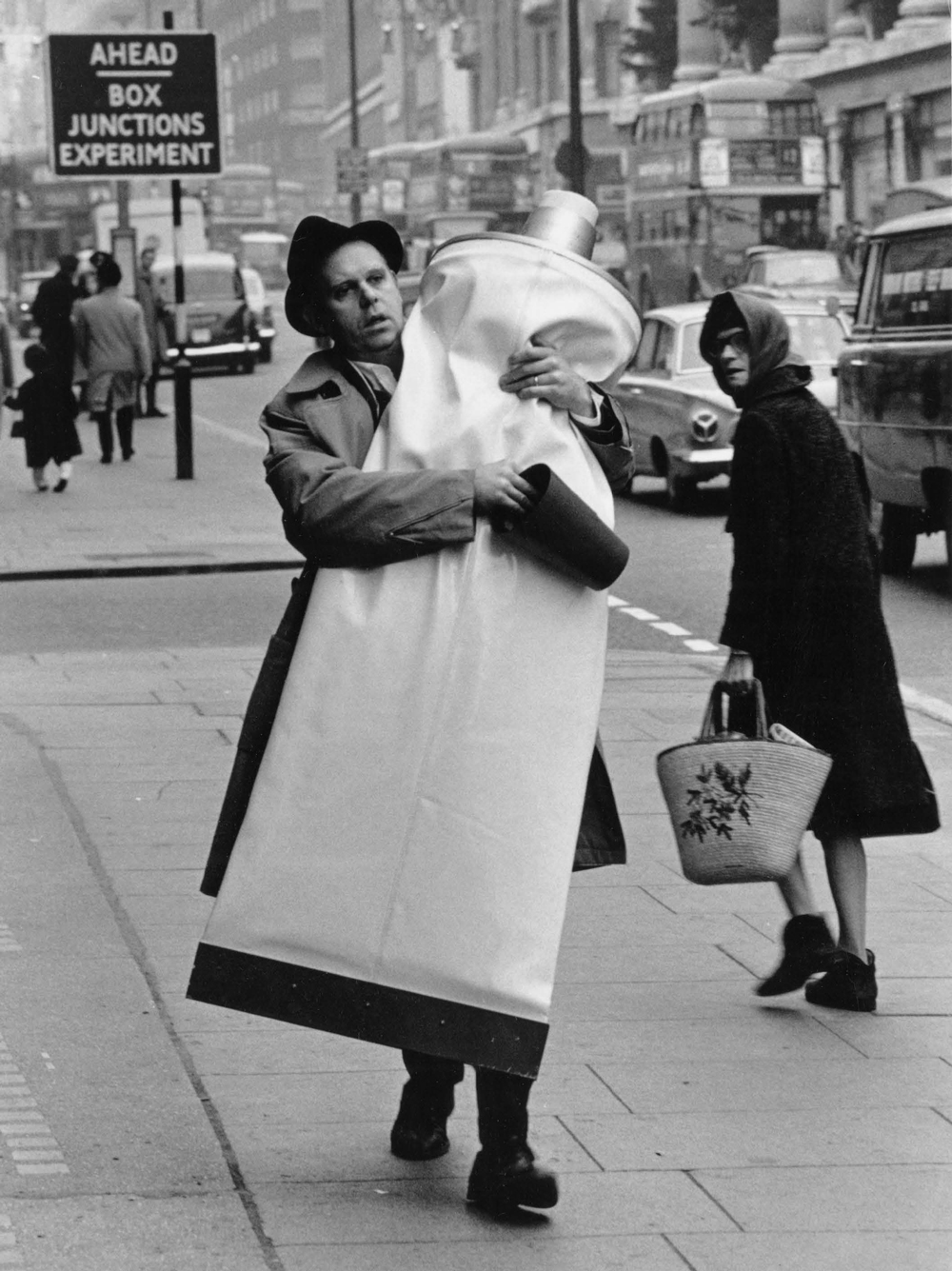My early impressions of Claes Oldenburg and his work were shaped largely by mass media. I tended to think of his work in association with Pop artists like Warhol, Lichtenstein, and Rosenquist—though also artists like Allan Kaprow and to a lesser extent, George Segal. I was aware that some of his work in the early 1960s emerged in conjunction with happenings and events that could be called a kind of street theatre. (A number of these happenings—“The Street,” “The Store,” etc.—actually took place at an improvised store-front studio Oldenburg, his wife (Patty Mucha) and others worked out of on Manhattan’s Lower East Side under the loose auspices of what Oldenburg, et al. dubbed “Ray Gun Theatre.”) Were they mere ‘props’ or were they sculpture? Clearly they were both; and as I’ve looked back periodically over his career, that early connection with New York street happenings seems increasingly formative to his development as a mature artist. But by the time I was primed for a deeper dive into this already vanishing world, I was heading for California (entirely unaware that Oldenburg himself would have his own brief sojourn in Los Angeles, before heading to Europe and eventually back to New York).
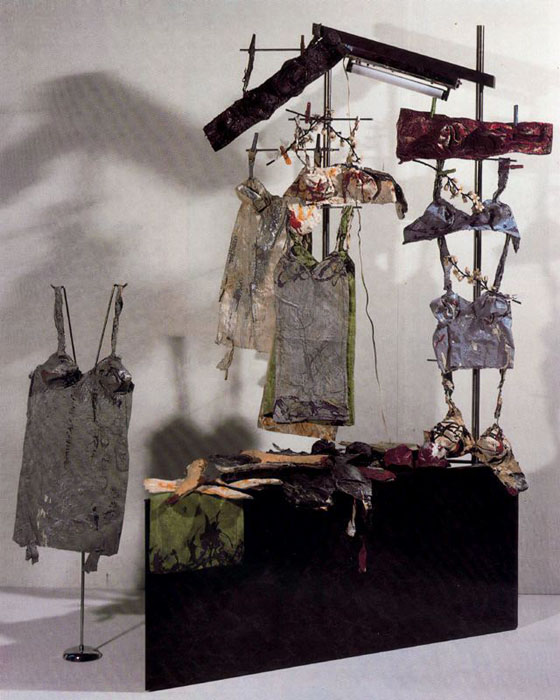
The first work I saw in magazines were painted plaster pieces, cardboard and papier-mâché, occasionally featuring brand names, which seemed to link him loosely to Warhol’s very early Pop paintings; also more ambiguous props, sculptures and set pieces—food or clothing that might be sold in a store or bakery, bedroom furniture and bathroom fixtures. Some of this was fairly ragged in appearance, but some of it was also hard-edged and sharply delineated. Later, encountering his work in a museum for the first time, I could see that his work had turned in a direction somewhere between those extremes—not quite so rough-edged, but also not entirely cool, detached or ironic. It was that same world alternately worn-out between care and familiarity, and blown-up to scale to our insatiable appetites and absurd ambitions. What to make of ghostly-white porcelain bathroom fixtures threatening to melt off the wall or collapse upon themselves, or hamburgers and ice cream cones scaled to feed a neighborhood?
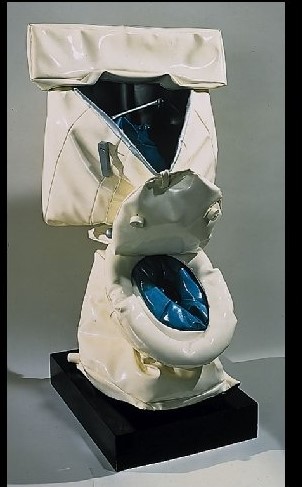
The surfaces were shiny smooth and slightly reflective vinyl. They had weight and presence, but didn’t necessarily look heavy; and we would soon learn they weren’t. Around the same time I also saw some of his drawings and sketches for ‘colossal’ monuments, most memorably, the Good Humor ice cream bar and one or two of his crushed cigarette butts or as they were then titled, ‘fagends’—both whimsical and fantastical, and simply wonderful drawings.
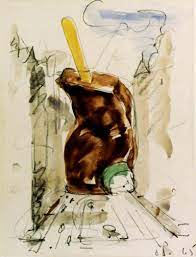
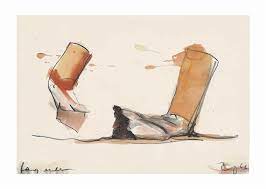 Desserts, common household or office tools, hardware, fastenings—frequently made soft, bendable or collapsible—were common subjects for such monuments. Although Oldenburg’s wit and humor are evident throughout his work, the drawings (and collage—e.g., his monumental lipsticks for Picadilly Circus, or toilet float-balls straddling a bridge over the Thames River in London) of these monument mock-ups have a wonderfully wry comic touch.
Desserts, common household or office tools, hardware, fastenings—frequently made soft, bendable or collapsible—were common subjects for such monuments. Although Oldenburg’s wit and humor are evident throughout his work, the drawings (and collage—e.g., his monumental lipsticks for Picadilly Circus, or toilet float-balls straddling a bridge over the Thames River in London) of these monument mock-ups have a wonderfully wry comic touch.
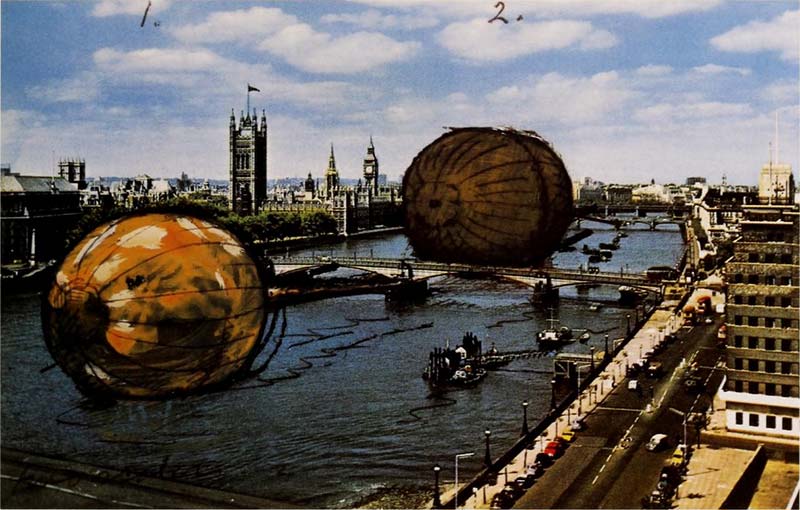
They also give some sense of his affinities with a number of peers some distance from the Pop domain. (Consider, e.g., his monumental ‘scissors’ intended to ‘replace’ the Washington Monument—with scissoring blades echoing George Rickey’s similarly scissoring kinetic constructions—perhaps more appropriate now than ever.)
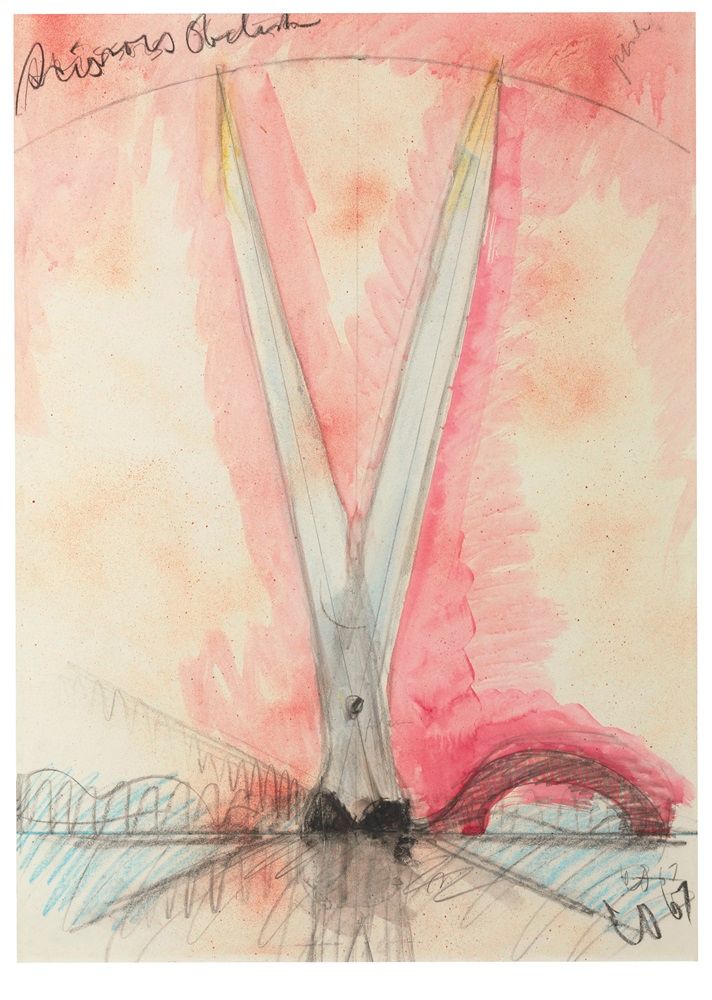 Interestingly, the toilet floats and monumental scissors also suggest Oldenburg’s interest in moving beyond mere conceit to something more durable, and actually monumental—from the street to the skyline. For an artist whose alternately Dada-street theatre and conceptual approach had so much to do with human scale (which in a sense is pre-blown-up, as he clearly understood) and the tactile dimension, he had a keen sense of placement, of architectural composition. Then too, this scaled with both of his hometowns (Chicago, as well as New York), with ever taller skyscrapers displacing earlier civic monuments since before the turn of the 19th century. Oldenburg’s original Good Humor ice cream bar was inspired by yet another monumental skyscraper doorstopping Park Avenue between Grand Central Terminal and the Helmsley Building—the PanAm (now MetLife) Building completed in 1963—though its silhouette more closely resembles the Helmsley (formerly New York Central) tower. (The original title for several iterations—variously in watercolor and pen-and-ink sketches—was Proposed colossal monument for Park Avenue, N.Y.C.—Good Humor bar).
Interestingly, the toilet floats and monumental scissors also suggest Oldenburg’s interest in moving beyond mere conceit to something more durable, and actually monumental—from the street to the skyline. For an artist whose alternately Dada-street theatre and conceptual approach had so much to do with human scale (which in a sense is pre-blown-up, as he clearly understood) and the tactile dimension, he had a keen sense of placement, of architectural composition. Then too, this scaled with both of his hometowns (Chicago, as well as New York), with ever taller skyscrapers displacing earlier civic monuments since before the turn of the 19th century. Oldenburg’s original Good Humor ice cream bar was inspired by yet another monumental skyscraper doorstopping Park Avenue between Grand Central Terminal and the Helmsley Building—the PanAm (now MetLife) Building completed in 1963—though its silhouette more closely resembles the Helmsley (formerly New York Central) tower. (The original title for several iterations—variously in watercolor and pen-and-ink sketches—was Proposed colossal monument for Park Avenue, N.Y.C.—Good Humor bar).
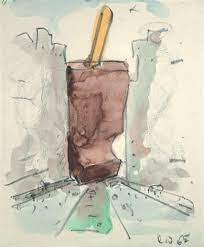
Oldenburg despised the pomposity of so many of the monuments that dominated public squares and plazas—the soldiers and generals (frequently on horseback), merchants, and dead presidents (Grant’s Tomb). The nature and quality of public art and sculptural installations was already beginning to change by the early 1960s, but it was as much of an uphill battle in New York (with its established grid of streets and squares) as it was elsewhere. I loved almost all the colossal monument drawings, but as concepts for actual monuments, some of them were effectively still-born; made concrete (or Cor-Ten steel), their fancy and fantasy would have perished. Consider his Proposed Colossal Monument for Central Park North (1965). It could be something out of Metropolitan (Nick or Taylor coming across Tom’s old Steiff Teddy in a box of discarded toys)—the toy, doll, or plush animal lost or left behind after an outing to the Park. It has a certain forlorn appeal—but is so wrong. The Park is the city’s last refuge for whimsy (especially Central Park—Alice In Wonderland, the carousel, the Wishing Well, sailboats at the Conservatory, etc.). At first I thought it might be a reaction to the Met’s pushing further into the Park. A consequence of the Museum’s installation of the Temple of Dendur? Easily conceivable—but that actually didn’t happen until 1967, and the (Sackler!) wing wasn’t even completed until 1978. It would have ended up looking as pompous and ridiculous (and annoying—especially to children!) as anything in the streets beyond the Park’s perimeter.
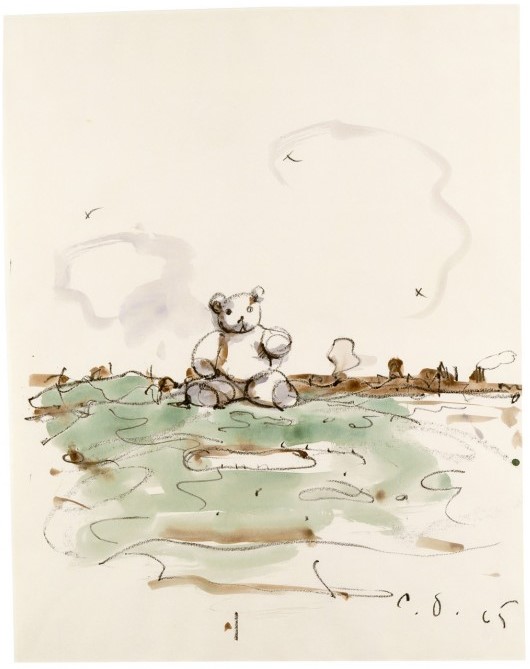
If I had any doubts about a fully realized and executed monument from one of these conceits, they were instantly dispelled by a photograph I saw in some college materials being perused by my brother, then pondering his academic future (and simply escape from our parents). It was a picture of Oldenburg’s Lipstick (Ascending) on Caterpillar Tracks (1969) parked outside Woolsey Hall at Yale. My delight was redoubled when I learned that when the sculpture was first rolled onto the Hewitt quad, the lipstick was actually an inflatable (later to be replaced by an aluminum or steel version). Trojan Horse, show-stopping theatrical tour-de-force—and army-of-the-night strike against the state with a wink and up-raised middle finger—this was more than public sculpture as performance. This was sculpture performing in the public interest. It would be a few years before I became acquainted with sculptors like Robert Morris, Richard Serra, and Mark di Suvero pushing into public consciousness on a comparable scale, but here was Oldenburg already critically and expansively engaging a broader cultural and political sphere.

It wasn’t too long before Oldenburg finally began winning commissions for large, if not monumentally scaled work (which would follow soon enough); but it was a few years into my own escape (also by way of college) before I had any sense of what that might look like. My refreshed encounter with Oldenburg’s work was also my first encounter with one of the first art books I seriously coveted for myself—a toss-up whether as fetishizable fashion object or critical art monograph. I suspect both—it was Barbara Rose’s catalog for Oldenburg’s 1970 MoMA retrospective, and I was already a fan of Barbara Rose’s critical writing. But the aesthetics—big soft floppy tome with a colorful hand-stitched vinyl (kapok-filled?) cover—were what sealed my passion with a mod-ish Fiorucci kiss. I loved that just holding the book or flapping it shut made me think of an Oldenburg toilet seat or light switches—‘yes, do continue to enjoy your household sculptures and your library sculptures, cutting into you or melting into your hands, as they may.’
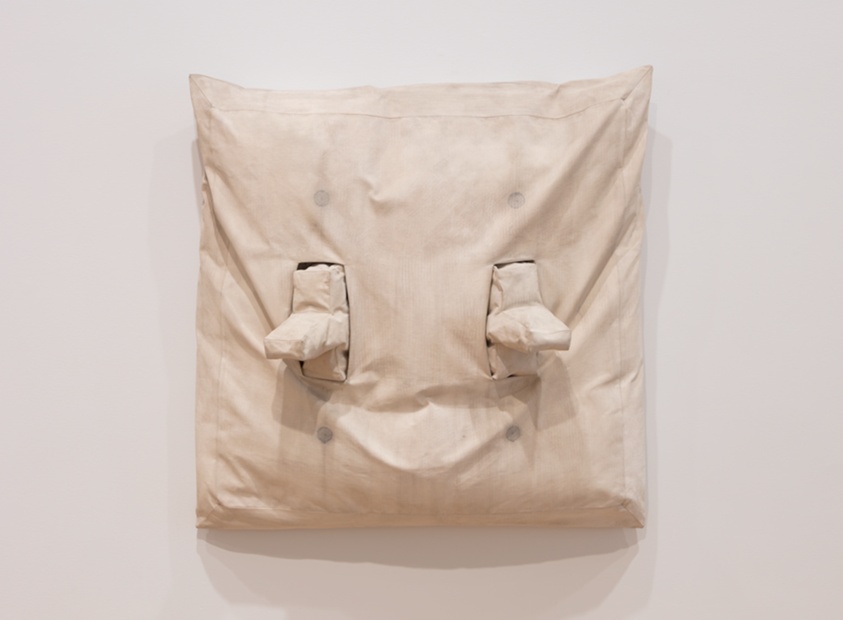
Rose continues to inform my view of Oldenburg’s work (and she was there—at the heart of a vibrant scene that I learned included other icons-in-the-making); but more importantly, the catalog was my first really comprehensive look at his work, from the ‘home, store and street’ to that place where instrumentality transfigured by imagination met a hypothetical, quasi-idealized ‘skyline’.
There was something slightly odd, almost unsettling about revisiting this work that I’d had glancing contact with in childhood, a charged reawakening to in adolescence, and now this overview that was both richly aesthetic and uncannily direct, but also tinged with nostalgia—a New York nostalgia certainly, viewed amid the California redwoods 3,000 miles away, but also for an expansive, transformative life (or perhaps simply a theatricalized way of looking at and living it) that seemed far from reach. It was the beginning of an odd, transitional time for me personally; and something about Oldenburg (and conceivably a few of his peers and predecessors—Warhol, Duchamp, Motherwell, Stella, Frank O’Hara) connected with my own preoccupations (and perhaps those of a few of my close pals)—physically distant, but somehow integrated and infused into the atmosphere we breathed, polluted, and made over into our incense. (Yes, I suppose drugs occasionally helped.) I listened to a lot of classical music and jazz in those days, but Village icons like Dylan and Baez were superstars; and Dylan’s [The] Band, The Rolling Stones, Neil Young, Joni Mitchell, Laura Nyro, David Bowie, Lou Reed, and his predecessor band, the Velvet Underground were all part of the soundtrack. Reed’s Transformer was like a constant ‘New York conversation’ “rattling in my head”—and it seemed to speak to this connection to the simultaneously mundane and fantastical, the lost and abject, the found and transformed that seemed to be at the center of Oldenburg’s work.
Oldenburg’s works are constantly showing us states of transformation that imply other states prior or to come—apprehension, preoccupation, observation and magnification, handling, grappling/turning/wedging/squeezing, displacing, transferring, break-down (interestingly discarding or disposing more often than, say, ‘repairing’), resistance, and persistence. (Also decay and collapse—though in most of his work, Oldenburg seems to suggest a continuity, implying a potential for regeneration, although we never see it.) Dali was far from Oldenburg’s most profound influence, but it’s almost impossible to think of some of Oldenburg’s earlier studies for ‘soft’ sculptures or monuments without thinking of some of Dali’s landscapes and dreamscapes—e.g., the melting clocks and watches of The Persistence of Memory (1931).
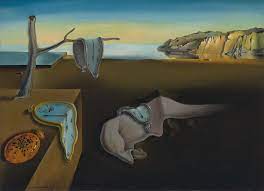
There is both persistence and exhaustion in equal measure in Oldenburg’s best work—the failed fantasy that flirts with ridicule, yet—in its sincerity and seriousness, its insistence upon its own poetic ontology and epistemology, its own terms of engagement—defies it. In the Oldenburg universe (which is to say, essentially, the city that exists in dynamic relationship with the bodies moving through it), the derailed, discarded, deflected utilitarian object that began its life in one state or relationship to its user acquires a fresh aura and skein of associations in its variably absurd or abject, yet transcendent space. Frank O’Hara, the great New York poet, was dead by the time Oldenburg began to realize some of his ‘proposed colossal’ (or slightly less-than-colossal) ‘monuments’; but his very New York spirit and street energy seems very much evident in some of Oldenburg’s earlier sketches and projects. Consider, e.g., from Lunch Poems, his Poem “en forme de Saw” or the sundry kitchen, office and workbench objects recited “On Rachmaninoff’s Birthday,” or his fan’s plea to the “collapsed” Hollywood icon, Lana Turner, and his final exhortation, “oh Lana Turner we love you get up.”
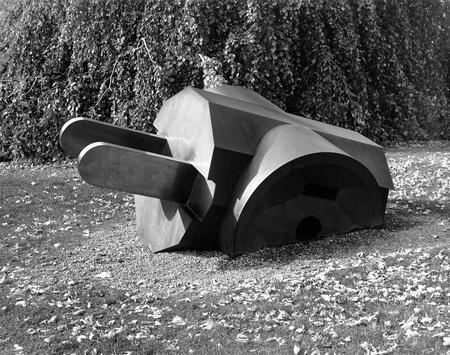
One of the great examples of this class of work is Oldenburg’s 1970 Giant Three-Way Plug (originally conceived for Oberlin College), variously executed after trials in sketches and maquettes in several different states, from Cor-Ten steel and bronze for Oberlin (above—also occasionally referred to as “Embedded”), to polished wood, to (in its various ‘Soft’ or melting renditions) paper and leather; also in a variety of sites both outdoor and indoor, in any number of installations and placements. (The Three-Way Plug is seen variously hanging or suspended from wall or ceiling, floating in water, and mounted on various plinths or bases.) In the Oberlin “embedded” installation, the Plug is both relegated to a generation of objects already in the process of burial and oblivion, yet revealing an aspect that magnifies its transformative power and demands fresh consideration—as if it were a kind of cannon, which in an odd way it is. In its various suspended and floating treatments (fashioned from a variety of materials), the Plug invites us to consider alternatively, a slightly forlorn and wayward trajectory, with its pins and terminals pivoted toward ceiling or sky, or hanging uselessly—inviting projections of helplessness, estrangement, and obsolescence.
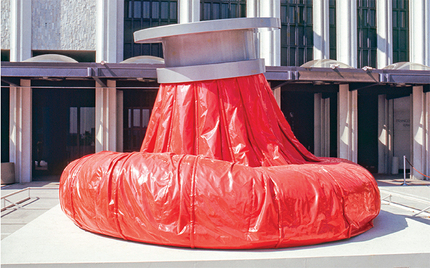
Then there are the sculptures that invite a continuously shifting reappraisal of bodies simultaneously grounded and moving continuously in space (i.e., the quintessential urban condition). Oldenburg put forward a number of ideas and sketches about various objects in motion or somewhere between motion and stasis during this same period and conceivably much earlier. (Warhol’s Silver Clouds (the famous silver mylar pillows he floated around the Factory and off its fire escape) appeared in 1966.) With some assistance from engineers (in fact from LACMA—and Maurice Tuchman’s Art and Technology program), Oldenburg conceived a kinetic version of what is variously titled Ice Bag or Giant Ice Bag (1969-71). At least three versions (of variable scale) of the sculpture were executed and LACMA’s is probably the best of them. Usually mounted on a plinth, inflated and motor-powered, the bag gently twists and undulates, inflates then collapses slightly, as if taking shallow breaths, as its metal cap shifts slightly to catch the light and odd reflection before reverting back into position. We have a sense of internal movement—oblong ice cubes shuffling about the interior, at least in our imagination—while from its oddly ceremonious mounting, we can almost imagine a superficially polite dowager in a crinolined gown ‘feeling fussy—not quite walking in her Balenciaga’, before retreating to a ‘fainting room’. (Or, more finally—and fatally—however spared burial or ‘embedding’, the dramatic ‘exhale’ and ‘respiratory’ failure of a collapsed parachute.)
This was also the period during which Oldenburg met—and eventually married—Coosje van Bruggen; and with van Bruggen, Oldenburg’s practice (or from approximately 1976, more specifically Oldenburg’s and van Bruggen’s joint practice) began to be dominated by truly monumental, even architecturally scaled work. As I was reminded by certain references in Suzanne Muchnic’s Los Angeles Times obituary—as well as an artist pal’s exasperation with the indiscriminate adulation he was seeing for a number of these monumental/architecturally scaled (and not infrequently corporate-sponsored or tax-subsidized) monuments and installations—these were far from uniformly successful.

Their first major commission (from the lawyer/real estate developer, Jack Wolgin, pursuant to the Philadelphia Redevelopment Authority’s assigning a small percentage of the project’s cost to a work of public art), timed in conjunction with American bicentennial commemorations for 1976, was the monumental (approximately 45 feet tall) Clothespin, which sits squarely above the Philadelphia City Hall subway station. (There are also two smaller versions of the work.) As public art goes, there’s no denying the work’s success; but it also marks a significant break with Oldenburg’s prior body of work, both in its prominent placement (not that the Helmsley or PanAm buildings wouldn’t have been prominent…), and its upright quasi-symmetrical silhouette. Whatever we think of when we think of clothespins, there’s nothing ‘soft’ going on here. This is about as soft as Philip Johnson’s AT&T building. Seriously—although much is made of an allusion to Brancusi’s The Kiss (which Oldenburg reportedly acknowledged), it’s really coming closer to the highest highboy you ever saw—or maybe a blacked-out Gumby in bondage—with that shallow quasi-Chippendale-cup incision at the top (yes—I know that’s what those kinds of clothespins look like); and I sometimes wonder if Oldenburg acknowledged a Brancusi influence or allusion (as if!) only so people would ignore its more likely influences—as in Tony Smith and Barbara Hepworth. Oldenburg is not beyond connoting that order of intimacy—but it doesn’t happen in that kind of pairing. Better to look for that kind of intimacy in, well—a plug, or a tube of toothpaste. (Really, it’s the wrap-around spring with its ‘7-6’ above the ‘legs’ of the monument that is as close to an emblem of intimacy as the monument comes.)
Oldenburg and van Bruggen went on to produce more than 40 such monuments over the course of almost three decades (until her death in 2009)—some of them brilliant, some more or less serviceable as public art, some little more than passable and almost a betrayal of Oldenburg’s artistic legacy, some gratuitous and on the verge of a public nuisance. We can be relieved/grateful that at least a few of these proposed ‘monuments’ (whatever the scale) were discarded. The Los Angeles Times alerted me to at least one of these—the ‘collar and bow tie’ intended for Disney Hall (just guessing—but perhaps a nod to traditional masculine evening costume once favored for formal occasions and for male orchestral conductors and musicians—but not since, uh, the early 20th century)—easily 180 degrees off the sort of symbolism or messaging Disney Hall or the Los Angeles Philharmonic—or any vital cultural institution in L.A. or anywhere else—would have cared to associate itself with. (A complete mystery as to why van Bruggen would have pushed a concept so utterly wrong-headed.) Yet their collaboration for Loyola Law School, a kind of choreographed visual expression of the notion of hazard, Toppling Ladder with Spilling Paint (1986) seems to me one of the most brilliant commentaries on the American legal and justice systems; and their Binoculars (1991) for the TBWA/Chiat/Day Agency (now occupied by Google) in Venice is quintessential Oldenburg, albeit, as with Clothespin, rigid and upright.
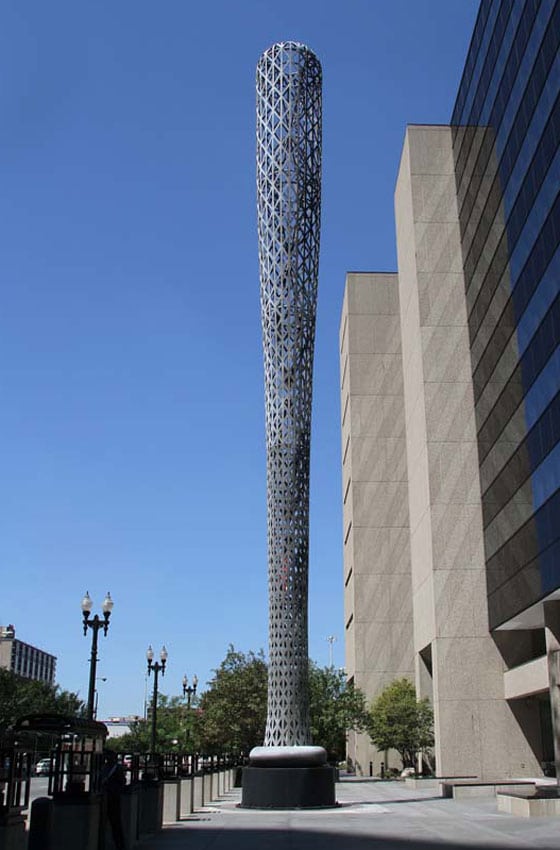
There’s no escaping the fact that Oldenburg had moved deliberately in the direction of an architectural scale from the time of his Oberlin College commission. But with certain exceptions—like the TBWA/Chiat/Day Binoculars—it is precisely these ‘colossal’, architecturally-scaled monuments where Oldenburg’s ‘transformative’ vision is most likely to fall flat or even fail. It is particularly frustrating to see when underlying concepts or ideas might have salvaged the project. Consider a similarly upright monument (which followed not long after the Wolgin/PRA-Philadelphia Clothespin)—the 1977 Batcolumn for (what is now the Harold Washington) Social Security Administration Building in Chicago. Its failure can be summed up in the title: success as architectural embellishment; failure as art, even public art. (And consider what Oldenburg might have done with a catcher’s mitt, or some assemblage of mitts and baseballs—miracle designs both at their very best.) He had more success with his Pool Balls (also 1977) for Münster; but—concrete? Really?? (Their 1981 Flashlight for U.N.L.V. is also somewhat more successful, both as art and design.) Neither bridge, nor actually spooning its cherry—borne aloft only at its edge; and despite its favorable reviews and some critical consensus, Spoonbridge and Cherry has never seemed particularly compelling or convincing. On the other hand, if it somehow offers some kids a bit of distraction from the terrors of their racist police force, we won’t begrudge them a moment’s diversion in the Minneapolis Sculpture Garden. (But to think what Oldenburg and van Bruggen might have done with Mary Tyler Moore’s tam-o-shanter.)
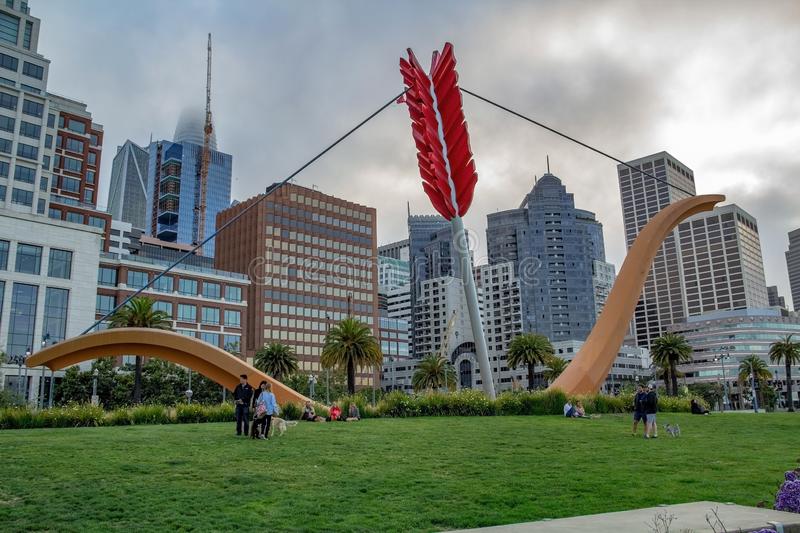
My artist pal had cited one particular Oldenburg/van Bruggen installation as particularly egregious: their 2002 Cupid’s Span, commissioned by Donald and Doris Fisher (of the Gap retail and garment manufacturing empire) for San Francisco’s Rincon Park. I might push back a bit on his criticism (which had as much to do with the effective taxpayer subsidizing of such grandiose monuments to private egos and public vice-masquerading-as-virtue), to take some pleasure in that sunken sine-cosine swoosh, beneath the aggression of that arrow’s tailfeathers—an echo of the ‘knife-ship’ they launched in Venice at the 1985 Biennale, with the bow sections still more closely resembling the gondolas that sailed alongside it. For those unable to abide it, there is the consolation of knowing that over the course of the next century (if we have that long) the entire installation may disappear from view—as this part of the San Francisco waterfront continues to sink into the Bay.
“Sailing ’round the world in a dirty gondola. Oh, to be back in the land of Coca-Cola.” Bob Dylan, “When I Paint My Masterpiece.”

Important to be reminded that Oldenburg’s collaborative practice with van Bruggen was not without its triumphs—and Il Corso del Coltello, which gave us Oldenburg’s and van Bruggen’s Knife Ship (and its variations—one of which was on view for a year at MoCA, while another unique iteration, the Knife Slicing Through Wall, was built on-site at the Margo Leavin Gallery at 817 Hilldale in West Hollywood and remained there until the gallery’s closing in 2013) was one of them. (Between Margo Leavin’s incomparable legacy and Oldenburg’s and van Bruggen’s own pronounced stamp on Los Angeles, it would be fitting for MoCA to acquire one of the Knife Ships for its permanent collection.) It helped that they had an impressive team of collaborators, including most prominently Frank Gehry and critic-curator, Germano Celant. Although Il Corso and the Knife Ships were mounted on a grand scale, it is not insignificant that Oldenburg was also returning to the foundational roots from which almost all of his work sprang: the ‘happening’, albeit a scripted one; street theatre with the sole distinction that the streets of Venice happen to be canals—with its key prop the ultimate morphing hand-held tool, the Swiss Army knife. Even the costumes hearken back to Oldenburg’s early “Ray Gun” performances (“Nekropolis,” “Voyages,” “Worlds Fair,” etc.), the stuff of which—props that became art and sculpture feeding back into an expanded studio practice—lit the fuse of his ensuing career.
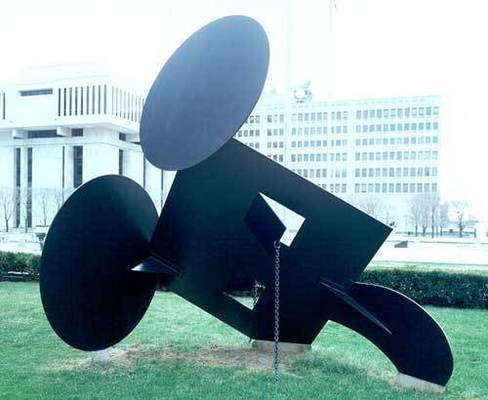
Geometric Mouse (1969), painted steel & aluminium (106×355 in.) – Empire State Plaza, Albany
Il Corso, on one level, is Oldenburg ‘coming to grips’ with the architectural scale of his rendering, transitory devices; the magnification and quasi-glamourization of mundane objects we exist in intimate proximity with, yet which connect us not merely in urban but global spaces. The screw really is a bridge in the Oldenburg/van Bruggen universe; and what the Swiss Army knife won’t move (or remove—the cap, the cork—with the corkscrew a distant echo of Archimedes’ screw), it will slice through—as many blades, trowels, shovels, and who-knows-what-else have moved earth and bodies (or torn through them) around Alps and rivers on the European continent and well beyond for the last 20 centuries or so. The voyage out begins with this essential apprehension, recognition, and connection with the device, the vehicle—the transit or transition that may become transformative. I’m not referring to Il Corso, specifically, but simply, within the scope of Oldenburg’s work, the soft (or sharp) machinery of transference and transformation. It isn’t necessarily straightforward. There are friction, resistance, obstacles, fatigue, exhaustion; and what remains—floating, embedded, drowned, saved, sea-changed. (I’ll take back that Teddy bear now).
“I am calling, yes I’m calling just to speak to you, / For I know this night will kill me, if I can’t be with you. / If I can’t be with you” Lou Reed, “New York Telephone Conversation” (Transformer, 1972).

